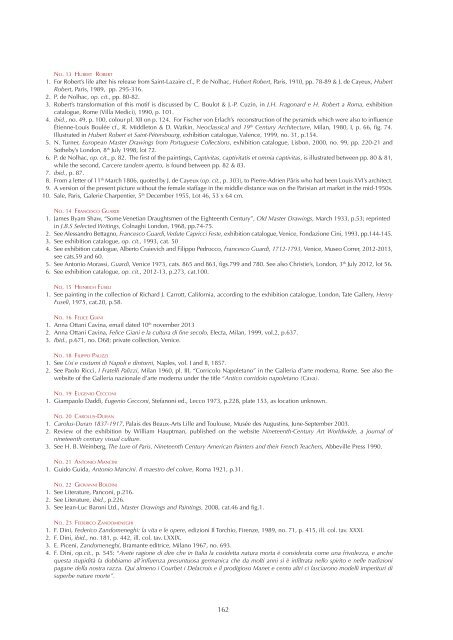Catalogue-2014-Jean-Luc-Baroni
- No tags were found...
You also want an ePaper? Increase the reach of your titles
YUMPU automatically turns print PDFs into web optimized ePapers that Google loves.
1.<br />
2.<br />
3.<br />
4.<br />
5.<br />
6.<br />
7.<br />
8.<br />
9.<br />
10.<br />
No. 13 Hubert Robert<br />
For Robert’s life after his release from Saint-Lazaire cf., P. de Nolhac, Hubert Robert, Paris, 1910, pp. 78-89 & J. de Cayeux, Hubert<br />
Robert, Paris, 1989, pp. 295-316.<br />
P. de Nolhac, op. cit., pp. 80-82.<br />
Robert’s transformation of this motif is discussed by C. Boulot & J.-P. Cuzin, in J.H. Fragonard e H. Robert a Roma, exhibition<br />
catalogue, Rome (Villa Medici), 1990, p. 101.<br />
ibid., no. 49, p. 100, colour pl. XII on p. 124. For Fischer von Erlach’s reconstruction of the pyramids which were also to influence<br />
Étienne-Louis Boulée cf., R. Middleton & D. Watkin, Neoclassical and 19 th Century Architecture, Milan, 1980, I, p. 66, fig. 74.<br />
Illustrated in Hubert Robert et Saint-Pétersbourg, exhibition catalogue, Valence, 1999, no. 31, p.154.<br />
N. Turner, European Master Drawings from Portuguese Collections, exhibition catalogue, Lisbon, 2000, no. 99, pp. 220-21 and<br />
Sotheby’s London, 8 th July 1998, lot 72.<br />
P. de Nolhac, op. cit., p. 82. The first of the paintings, Captivitas, captivitatis et omnia captivitas, is illustrated between pp. 80 & 81,<br />
while the second, Carcere tandem aperto, is found between pp. 82 & 83.<br />
ibid., p. 87.<br />
From a letter of 11 th March 1806, quoted by J. de Cayeux (op. cit., p. 303), to Pierre-Adrien Pâris who had been Louis XVI’s architect.<br />
A version of the present picture without the female staffage in the middle distance was on the Parisian art market in the mid-1950s.<br />
Sale, Paris, Galerie Charpentier, 5 th December 1955, Lot 46, 53 x 64 cm.<br />
1.<br />
2.<br />
3.<br />
4.<br />
5.<br />
6.<br />
No. 14 Francesco Guardi<br />
James Byam Shaw, “Some Venetian Draughtsmen of the Eighteenth Century”, Old Master Drawings, March 1933, p.53; reprinted<br />
in J.B.S Selected Writings, Colnaghi London, 1968, pp.74-75.<br />
See Alessandro Bettagno, Francesco Guardi, Vedute Capricci Feste, exhibition catalogue, Venice, Fondazione Cini, 1993, pp.144-145.<br />
See exhibition catalogue, op. cit., 1993, cat. 50<br />
See exhibition catalogue, Alberto Craievich and Filippo Pedrocco, Francesco Guardi, 1712-1793, Venice, Museo Correr, 2012-2013,<br />
see cats.59 and 60.<br />
See Antonio Morassi, Guardi, Venice 1973, cats. 865 and 863, figs.799 and 780. See also Christie’s, London, 3 th July 2012, lot 56.<br />
See exhibition catalogue, op. cit., 2012-13, p.273, cat.100.<br />
1.<br />
No. 15 Heinrich Fuseli<br />
See painting in the collection of Richard J. Carrott, California, according to the exhibition catalogue, London, Tate Gallery, Henry<br />
Fuseli, 1975, cat.20, p.58.<br />
1.<br />
2.<br />
3.<br />
1.<br />
2.<br />
No. 16 Felice Giani<br />
Anna Ottani Cavina, email dated 10 th november 2013<br />
Anna Ottani Cavina, Felice Giani e la cultura di fine secolo, Electa, Milan, 1999, vol.2, p.637.<br />
Ibid., p.671, no. D68; private collection, Venice.<br />
No. 18 Filippo Palizzi<br />
See Usi e costumi di Napoli e dintorni, Naples, vol. I and II, 1857.<br />
See Paolo Ricci, I Fratelli Palizzi, Milan 1960, pl. III, “Corricolo Napoletano” in the Galleria d’arte moderna, Rome. See also the<br />
website of the Galleria nazionale d’arte moderna under the title “Antico corridoio napoletano (Cava).<br />
1.<br />
1.<br />
2.<br />
3.<br />
No. 19 Eugenio Cecconi<br />
Giampaolo Daddi, Eugenio Cecconi, Stefanoni ed., Lecco 1973, p.228, plate 153, as location unknown.<br />
No. 20 Carolus-Duran<br />
Carolus-Duran 1837-1917, Palais des Beaux-Arts Lille and Toulouse, Musée des Augustins, June-September 2003.<br />
Review of the exhibition by William Hauptman, published on the website Nineteenth-Century Art Worldwide, a journal of<br />
nineteenth century visual culture.<br />
See H. B. Weinberg, The Lure of Paris, Nineteenth Century American Painters and their French Teachers, Abbeville Press 1990.<br />
1.<br />
1.<br />
2.<br />
3.<br />
1.<br />
2.<br />
3.<br />
4.<br />
No. 21 Antonio Mancini<br />
Guido Guida, Antonio Mancini. Il maestro del colore, Roma 1921, p.31.<br />
No. 22 Giovanni Boldini<br />
See Literature, Panconi, p.216.<br />
See Literature, ibid., p.226.<br />
See <strong>Jean</strong>-<strong>Luc</strong> <strong>Baroni</strong> Ltd., Master Drawings and Paintings, 2008, cat.46 and fig.1.<br />
No. 23 Federico Zandomeneghi<br />
F. Dini, Federico Zandomeneghi: la vita e le opere, edizioni Il Torchio, Firenze, 1989, no. 71, p. 415, ill. col. tav. XXXI.<br />
F. Dini, ibid., no. 181, p. 442, ill. col. tav. LXXIX.<br />
E. Piceni, Zandomeneghi, Bramante editrice, Milano 1967, no. 693.<br />
F. Dini, op.cit., p. 545: “Avete ragione di dire che in Italia la cosidetta natura morta è considerata come una frivolezza, e anche<br />
questa stupidità la dobbiamo all’influenza presuntuosa germanica che da molti anni si è infiltrata nello spirito e nelle tradizioni<br />
pagane della nostra razza. Qui almeno i Courbet i Delacroix e il prodigioso Manet e cento altri ci lasciarono modelli imperituri di<br />
superbe nature morte”.<br />
162
















